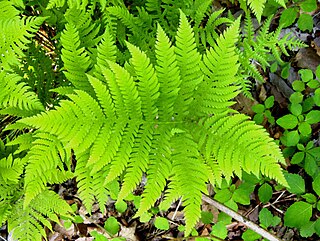
Phegopteris is a genus of ferns in the family Thelypteridaceae, subfamily Phegopteridoideae, in the Pteridophyte Phylogeny Group classification of 2016. They are known collectively as the beech ferns. Species are native to Asia, North America and Europe.

Heracleum maximum, commonly known as cow parsnip, is the only member of the genus Heracleum native to North America. It is also known as American cow-parsnip, Satan celery, Indian celery, Indian rhubarb, poison turnip or pushki.

Cardamine is a large genus of flowering plants in the mustard family, Brassicaceae, known as bittercresses and toothworts. It contains more than 200 species of annuals and perennials. Species in this genus can be found in diverse habitats worldwide, except the Antarctic. The name Cardamine is derived from the Greek kardaminē, water cress, from kardamon, pepper grass.

Ptilimnium is a group of plants in the family Apiaceae described as a genus in 1819. The common name is mock bishopweed or mock bishop's weed. It is endemic to the United States, primarily in the Southeast, the Lower Mississippi Valley, and the Lower Great Plains.

Ampelopsis, commonly known as peppervine or porcelainberry, is a genus of climbing shrubs, in the grape family Vitaceae. The name is derived from the Ancient Greek: ἅμπελος (ampelos), which means "vine". The genus was named in 1803. It is disjunctly distributed in eastern Asia and eastern North America extending to Mexico. Ampelopsis is primarily found in mountainous regions in temperate zones with some species in montane forests at mid-altitudes in subtropical to tropical regions. Ampelopsis glandulosa is a popular garden plant and an invasive weed.

Polygonum is a genus of about 130 species of flowering plants in the buckwheat and knotweed family Polygonaceae. Common names include knotweed and knotgrass. In the Middle English glossary of herbs Alphita, it was known as ars-smerte. There have been various opinions about how broadly the genus should be defined. For example, buckwheat has sometimes been included in the genus as Polygonum fagopyrum. Former genera such as Polygonella have been subsumed into Polygonum; other genera have been split off.

Bartonia is a genus of the gentian family, tribe Gentianeae, subtribe Swertiinae. Members of this genus are called screwstems. Bartonia was also the name of a genus in the Loasaceae family, but those species are now generally classified under the genus Mentzelia.

Podophyllum is a genus of flowering plant in the family Berberidaceae, native from Afghanistan to China, and from southeast Canada to the central and eastern United States. The genus was first described by Carl Linnaeus in 1753.

Cardamine concatenata, the cutleaved toothwort, crow's toes, pepper root or purple-flowered toothwort, is a flowering plant in the family Brassicaceae. It is a perennial woodland wildflower native to eastern North America.
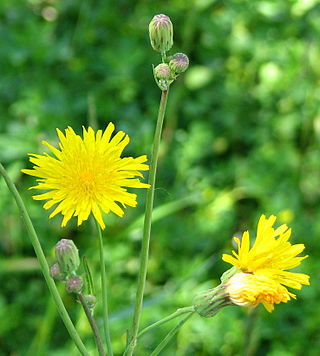
Hieracium umbellatum, the Canadian hawkweed, Canada hawkweed, narrowleaf hawkweed, or northern hawkweed, is a flowering plant in the family Asteraceae.

Artemisia campestris is a common and widespread species of plants in the sunflower family, Asteraceae. It is native to a wide region of Eurasia and North America. Common names include field wormwood, beach wormwood, northern wormwood, Breckland wormwood, boreal wormwood, Canadian wormwood, field sagewort and field mugwort.

Podostemum is a genus of plants in the family Podostemaceae. It is an aquatic plant with threadlike roots that attaches to rocks.
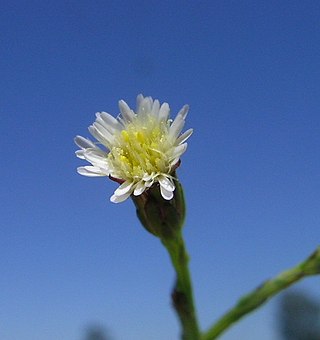
Symphyotrichum subulatum, commonly known as eastern annual saltmarsh aster or, in Britain and Ireland where it is naturalized, annual saltmarsh aster, is an annual plant in the family Asteraceae native to the eastern United States and the Gulf Coast to Texas. The species grows primarily in coastal salt marshes, although in the Ozarks it occurs as a non-marine weedy variety.
Polygonum exsertum is a species of flowering plant in the family Polygonaceae, native to Illinois. It was first described by John Kunkel Small in 1894.
Aristida dichotoma, known as churchmouse threeawn, fork-tip three-awn, pigbutt three-awn, and poverty grass, is a species of grass from eastern North America. It is native to the Eastern and Midwestern United States and Ontario, Canada. It has been introduced in California. It was described in 1803 by André Michaux.

Hypericum frondosum, the cedarglade St. Johnswort or golden St. John's wort, is a species of flowering plant in the St. John's wort family, Hypericaceae. It is native to the central and southeastern United States in dry, rocky habitats.

Dichondra carolinensis, commonly known as Carolina ponysfoot, is a small herbaceous plant native to Bermuda and the south-eastern United States.
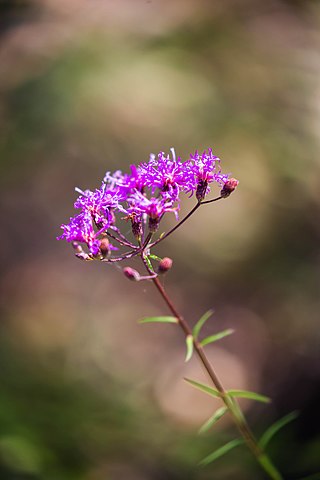
Vernonia angustifolia is a species of flowering plant in the family Asteraceae, native to the southeastern United States. It was first described by André Michaux in 1803.
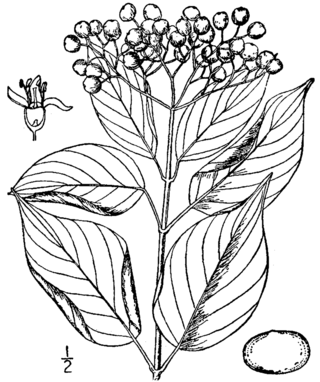
Cornus asperifolia, called toughleaf dogwood, is species of Cornus native to the southeastern United States. A shrub or small tree typically 3 to 5 m tall, it has yellow‑white flowers and white fruit.

Mononeuria is a genus of flowering plants belonging to the family Caryophyllaceae.

















